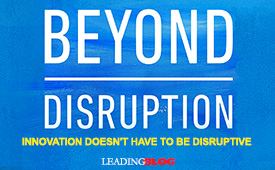The Illusion of Innovation
ORGANIZATIONS are better managed than ever before. They have been optimized for safety, security, stability, and control. But what we need going forward is dynamic and, yes, inefficient. What is needed now is some deliberate chaos.
In The Illusion of Innovation, author Elliott Parker believes that the focus on capital efficiency makes companies less capable of making big innovation bets that progress society because those bets have an uncertain payoff. The problem is that managing for predictability negates learning and progress. They are optimized for the wrong outcomes—predictability, not learning. The result is the illusion of innovation and progress while sacrificing resiliency.
Over the long run, resilience beats efficiency and is, therefore, a more productive objective for scaled organizations. Innovation can (and should) be directed at both efficiency and resilience. Still, the pendulum often swings too far to efficiency, which produces organizations that are extraordinarily fragile and subject to shocks. The challenge is that our scaled organizations are optimized for the preservation of what already exists, not for building the new.
Inefficiency creates learning. Corporations waste money and time on innovation efforts that destroy value. Efficient and scaled organizations may make fewer mistakes but have fewer insights. To correct this, they try to “repurpose their existing operating system—designed for efficient, scaled execution—to do something it was never designed to do: operate with a degree of inefficiency to create learning. Clayton Christensen wrote, “The worst place to develop a new business model is from within your existing business model.”
There are circumstances when an organization should look externally to create innovation. “Scaled companies are organized to execute. If an opportunity presents an execution challenge—when you know what to do and just need to do it—pursue it internally. Scaled companies are not organized to learn, so if an opportunity presents a learning challenge—when there’s a high degree of ambiguity about how to proceed—the opportunity is more likely to be successful if pursued outside the corporation.” Executing on a learning challenge only reinforces and perpetuates what you are already doing, creating the illusion of innovation.
What about the admonition for organizations to act like a startup? The answer is not to act like a startup but to learn to collaborate with outside experts and startups.
Many corporate executives are tempted to look at startup successes and instruct their teams to act more like a startup. For most corporations, this would be a terrible mistake—despite the many well-known successes, most startups fail. Corporate strength lies in coordination, not nimbleness, and in efficiency of execution, not speed.
An organization that is resilient requires a certain degree of inefficiency, randomness, serendipity, and exploration. “Fragility, on the other hand, results from too much focus on efficiency and is often the output of a top-down, hierarchical organizational structure over time.”
But all of this exploration and experimentation is a process with constraints. It is essential to link strategy and constraints.
Innovation is unlikely to succeed if the strategic bounds are not established and agreed upon. An organization’s leaders must determine where the organization will play and how it will win. All good strategies are controversial because they represent real choices. Yes, innovators should seek novelty, but within the constraints of the organization’s available resources and stated strategy. The most valuable experiments are those that are likely to create findings that lead to experiments, that generate findings that challenge the status quo—within strategic constraints.

![]()


Posted by Michael McKinney at 02:20 PM
Permalink
| Comments (0)
| This post is about Creativity & Innovation




